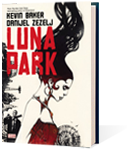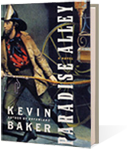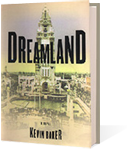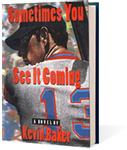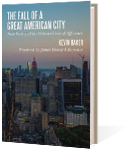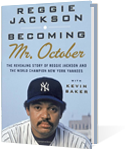A Life in the Twentieth Century
Innocent Beginnings, 1917-1950
by Arthur M. Schlesinger, Jr.
Houghton Mifflin
557 pages
Liberalism is the only mature political philosophy of our time. That is, it is the only philosophy that is suited both to man’s virtues, and to his inevitable flaws, to his aspirations and to his desires. It is the only one that has insisted on seeing him both as actor and as victim.
In the years between the nadir of the Great Depression, in 1932-33, and the first oil shock in 1973, liberalism—that is to say, primarily the modern, American brand of political liberalism—produced undeniably the greatest confluence of human liberty, opportunity, and prosperity that the world has ever witnessed.
Yes, before the coming of the New Deal, the United States was already a country of immense energy and genius—one perennially wracked by economic meltdowns, labor strife, savage racial oppression, and gaping social inequities. It was liberalism that provided a viable system of liberty in the industrial age. One that enabled, as David Fromkin terms it in In the Time of the Americans, the creation of “the magnificent country”—those years when the United States bestrode the planet as no other nation ever has. This was a time when America dispatched the two great totalitarian ideologies of the century, and speeded the break-up of the old colonial empires; when its citizens blithely dominated the globe, not only through military might and industrial production, but in high art and popular culture, from the fields of plenty to the frontiers of space, from the patent office to the Olympic games.
Which is one reason why Arthur M. Schlesinger, Jr.’s autobiography, A Life in the Twentieth Century: Innocent Beginnings, 1917-1950, lacks the melodrama we have come to expect from the standard American intellectual memoir. The great covention of the genre, after all, has become one of conversion, usually from Communism to rabid anti-Communism. The tedious pendulum swing of determinism, from one infantile, absolutist side to the other—from man as a function of inexorable Marxian laws, to man as a cog in the great, shiny clockwork of the market—is precisely what’s absent from Schlesinger’s book, as it has been from his intellectual life.
“It is, I suppose, evidence of lack of imagination or of some other infirmity of character, but I am somewhat embarrassed to confess that I have not radically altered my general outlook in the more than half century since The Vital Center’s publication,” writes Schlesinger, referring to the work that first fully defined his abiding liberal faith. “Perhaps I should apologize for not being able to claim disillusions, revelations, conversions. But in fact I have not been born again, and there it is.”
Even more annoying than his consistency, is how how consistently Schlesinger has been right. He was right about the need to stand up to Hitler and fascism in the thirties, and right about the need to contain Stalin and communism in the forties. He was right in refusing to join the fellow-traveling Progressive in 1948 and right in standing up to cynical conservatives seeking to exploit anti-Communism to their own ends. He remains largely right even today, in objecting to multicultural reduction of the American left to a meaningless stew of identity politics.
But above all, he has been right about liberalism. For all of the stupidity and the greed that were also part of the story, for all of the ecological rapaciousness, or the failure to sufficiently aid the developing world, or the disaster of Vietnam—all the predictable atrocities of state—it was the liberal idea that lifted the United States, and the rest of the Western and developed world that it had rescued, up to new heights of human possibility.
Yet this is already becoming the forgotten story of the twentieth century. The standard, media-blended versions circulating since the millenium attribute America’s superpower status solely to the vague triumph of “capitalism”—or that most generic brand, “freedom”—over Communism.
This is a meaningless confabulation—particularly in a society that increasingly regards freedom as a larger selection of television channels (from a single cable provider), or the right to transmit code viruses, sexual fantasies, and blustery insults over the internet. During last year’s New Hampshire primary campaign, a public radio reporter interviewing a band of high-school Steve Forbes supporters recorded their ecstatic hope that their candidate’s election would mean the freedom to skateboard at will in downtown Concord, and to mail in their anticipated tax returns on a postcard. Best we don’t stand in the doorway or block up that hall.
“Freedom” can, and has, meant just about anything to anyone over the past hundred years or so, as Arthur Schlesinger, Jr. discovered firsthand. His great contribution has been to so constantly seek its real meaning, in such seminal works of political philosophy and theory as The Vital Center, The Imperial Presidency, and The Cycles of American History, or to chronicle its progress, in such histories as The Age of Jackson; A Thousand Days: John F. Kennedy in the White House; and especially his majestic, three-volume work, The Age of Roosevelt, which must rank among the greatest historical works of the century.
In keeping with his central creed of man as a character possessed of free will, Schlesinger has been as well an unflagging partisan—a member of the Kennedy White House, and as a speechwriter for Adlai Stevenson and many other liberal politicians. He has been an insouciant, rakish presence around one debating table or another for half a century now; a sort of boyish Ichabod Crane in his trademark bowtie, possessed of a terrible swift and direct mind and a rasping New England tongue. Here is the true happy warrior, the historian as Cyrano—plunging joyfully into the fray against all odds and fashions, roiling academia anew with his 1991 polemic, The Disuniting of America: Reflections on a Multicultural Society. He seems, in short, to have led about as full a public life as a man of letters is capable of, with a happy knack for being in the right place at the right time.
Born in 1917, Schlesinger appears to have led an idyllic childhood—several of them, in fact. There are the early memories of shooting off firecrackers from the lush, green lawn of the family homestead in Xenia, Ohio. There is the move to Cambridge, Massachusetts when Dad, Arthur, Sr., an eminent scholar in his own right, as an early champion of the groundbreaking “New History” movement, joins the Harvard faculty. Growing up in a home full of politics and history, music and scintillating conversation—one so routinely crowded with the blithest spirits and finest minds of academia that young Arthur initially mistakes the great Western historian Bernard DeVoto for the family bootlegger.
There is even a trip around the world at the precocious age of 15—by rail through Canada, then across the Pacific and down around the rim of Asia, through Japan, China, Saigon and Angkor Wat, Bangkok, India, and up through Aden and Suez to Europe—a grand tour through the penumbra of the fading colonial world. Later, after Harvard and a first book at the age of 21, there is a Rhodes scholarship to England’s Cambridge—just in time for the nervous year of 1938-39, the Munich Crisis and the dreadful, unreal descent into war. And then the whirlwind—back to Harvard for more graduate work, marriage, family, and a start on his seminal work, The Age of Jackson. Then the war, and bureaucratic postings in Washington and Paris—another perfect, observer’s cockpit for a young historian.
The book, which was finished in spare moments during the war, won him the Pulitzer, national fame, and 25 weeks on the bestseller list, all at the age of 28. All Schlesinger managed to do was to change the entire, popular understanding of Jackson’s rise to power and the America of his time, tracing how so much of the great, populist contest of the time emerged not from celebrated, rugged, frontier America, but from the emerging industrial—and multicultural—struggles in the Eastern cities. Afterwards, he entered on a brief journalistic career spent interviewing the leading political figures in America in the late forties, much intellectual combat with conservatives and communists alike, and finally “settling down” on the Harvard faculty along with his father—just down the street from the Julia Childs, and William James’s son, and over the fence from the John Kenneth Galbraiths.
Such a life! We are treated to an endless succession of sparkling dinner parties, searing philosophical debates, grand theatre openings; a parade of brilliant colleagues and their dazzling wives (young Arthur gets dazzled a lot, one of his more endearing qualities.) But there is the rub. Too much of A Life in the Twentieth Century reads like a testament to the destructive power of a diary. This is especially disappointing, given that Schlesinger’s forte as a historian has always been his ability to convert enormous amounts of information into brilliant, literary narratives.
There are some vivid scenes here, particularly from the years leading up to the Second World War. In the spring of 1939, Schlesinger watches as a routine, Wimbledon doubles match a few weeks later, between a German team and two Frenchmen, turned into a sudden foreboding of war, with the crowd throwing off its English reserve and cheering wildly for the French. Later, in an almost novelistic passage, he drives west across the United States with Benny DeVoto, in the summer of 1940—discussing whether or not the U.S. should intervene in Europe as they move farther and farther away, into the heartland. Dropping in, a few days after the fall of Paris, at an evangelist camp meeting near Coeur d’Alene, Idaho, Schlesinger finds himself “along a black lake, the waters rippling in the mild wind, a half-moon faintly glimmering above. One first heard an indistinct moaning, weird cries rising out of the crowd…”
But soon those weird, mystic cries fade—and back march the endless lists of plays and movies, professors and fellow students, favorite actors and singers, the dinner parties and the cocktails. The sunsets and the dooryards and the sprinkled streets; the novels, the teacups—yet very few skirts that trail along the floor. Herein lies another problem. When it comes to anything of an intimate nature it is as if the author has—like his greatest subject, Franklin Delano Roosevelt—mastered the art of misdirection through overwhelming loquaciousness. (A Life in the 20th Century is 557 pages long, with index, and carries the reader only into its subject’s thirty-third year.) It is hard to say whether this should be attributed to an ingrained WASP reticence or a stoical disposition. We are granted only the barest glimpses of any emotional turmoil from his childhood. A camp report that describes him as popular—and adds, “Emotionally, he is a little high-strung.”
A general picture of an adolescent a little too unsure around girls, a little too sure of his opinions, as bookish boys often are. We can surmise that the parental bonds are close; his letters to them both are filled, well into adulthood, with details of his personal and professional life. Yet aside from the wistful suggestion that his father spent too much time editing other people’s work, in his mammoth A History of American Life series, there is little on his decision to work in the same field, no inner thoughts or conflicts, particularly over surpassing his father’s accomplishments (at least in the public’s eye) at such a young age. And when, by the tender age of fourteen, young Arthur decides to change his middle name from “Bancroft” to “Meier” and append the “junior” on the result, we are not given an explanation. What sort of love, or hero-worship—what kind of insecurity about his own identity—might evoke such a gesture from an adolescent boy? We are given no clue, only a breezy paragraph or two on other famous juniors.
The four children he has fathered by the end of the book, and his one sibling, a younger brother named Tom, are barely mentioned at all. There are intimations that his marriage to his first wife, Marian Cannon, is doomed from the start—but we are given little reason beyond the fact that she is five years older. When the book finds him stationed in Paris, in 1944-45, his descriptions of his relationships with both Tom and Marian reach almost laughable levels of evasiveness. There he has an affair with an unnamed woman, and his brother comes through town on his way to the front. Schlesinger’s ambivalence about both these liaisons is conveyed almost entirely through excerpts from a pair of short stories he submitted to the New Yorker at the time!
His impressions of less intimate friends and acquaintances are more verbose but hardly more enlightening. He bends over backward to give a scrupulous, and usually favorable, account of nearly everyone he has ever met. “To my surprise, I found that I liked him,” he writes on interviewing “Mr. Republican,” Senator Robert Taft in 1947. We are not in the least surprised, for Schlesinger has already established himself as a sort of Will Rogers of the political world, proclaiming his personal affection for everyone from communists to conservatives, including those he has engaged in furious political debate. This speaks well for both the man and the historian: Integrity runs like a silver thread throughout Schlesinger’s life and work (and thus we are also supplied with both critical and favorable reactions to almost everything he wrote up to 1950.) This is not, however, why we read autobiographies.
Perhaps the historian is simply trying to leave a trustworthy, objective record of his time. Hence his reaction to nearly every treasured novel, every movie, every television show, every play—including university productions. But the usefulness of his cultural reactions, too, is often muted by the creeper vines of fogeyism. A Life in the Twentieth Century is peppered with the sort of parenthetical remarks your grandfather thinks of as real zingers, such as how “gay” used to mean something else before homosexuals took it over, or how “man” used to refer to all of humanity, or why can’t we call “Native Americans” Indians anymore.
Much of this is not-so-subtlely directed toward Schlesinger’s most recent dragon, “the multiculturalists.” A worthy target—but the professor more often ends up disemboweling himself with his own rapier. Most annoyingly, he possesses his generation’s tin ear on matters of color, informing us that “In 1997, dining with Henry Louis Gates, Jr., Stanley Crouch and the New York Times columnist Bob Herbert, I was cheered to learn that many black Americans also enjoyed ‘Amos ’n’ Andy.” Later, he writes of how “In the tolerant days of my youth, the comedian Eddie Cantor could cheerfully go on in blackface and describe himself as the coon from Kuhn Loeb and Company—a harmless joke that in later days would offend two minority groups, or at least their self-anointed spokesmen.” Yes, and that Hank Aaron fellow is certainly a credit to his race.
Schlesinger is always on much firmer ground when he writes about ideas, and the great sweep of history. Even here, his memoir is hamstrung by a structure that all too often fails to link thoughts and events. We get little real analysis of Roosevelt or the New Deal, for instance, apparently because Schlesinger is saving that for the next volume of his life, in which he actually published The Age of Roosevelt. There is more discussion of the Truman administration, but only a passing reference to Richard Nixon in the Hiss case (we can only assume Dick Nixon won’t get his final kicking around until the pages that also deal with Schlesinger’s A Thousand Days.) Schlesinger describes how he came down, with reservations, on the side of judicial restraint in a 1947 article he wrote about the Supreme Court—yet we are given no indication of how he might apply that opinion to the civil rights era, when the Court had to abandon much of its traditional restraint because both the executive and legislative branches decided to basically punt on the issue.
What ultimately makes A Life in the Twentieth Century worth the plod is mostly the climax, when event and analysis finally coincide. This concerns the intriguing, turbulent years right after World War II, before the Cold War sides have quite set. Schlesinger becomes fully embroiled in the battle to fend off both Stalinism and the reprehensible attempt by the American right to exploit the Cold War for its own purposes—culminating in his publication of what may well prove to be his most important work, The Vital Center. Here, in describing the road to the one real epiphany of his life, Schlesinger’s thoughts and words ring like crystal. First there is the Damascene moment in the winter of 1940-41 when, still chary after Coeur d’Alene, he is dragged by his wife to listen to an obscure, balding, middle-aged theologian named Reinhold Neibuhr, speak at Harvard’s Memorial Church.
“His eyes flashed; his voice rose to a roar and sank to a whisper; outstretched arms gave emphasis to his points; but, underneath the dramatics, the argument was cool, rigorous and powerful,” Schlesinger writes of that Sunday, sixty years ago. “Man was flawed and sinful, he told the hushed but initially dubious audience. Yet even sinful man had the duty of acting against evil in the world. Our sins, real as they were, could not justify our standing apart from the European struggle.”
It sounds almost quaint from today—an intellectual revolution, engendered by a campus sermon. Or perhaps all too familiar—after a campaign spent watching the current White House incumbent refer to the Son of Man as if He were one more Bush family retainer. Neibuhr was no televangelist, however, but an activist and an intellectual, a man whose own, rock-like faith had been tested by his ministry in the slums of Detroit during World War I. The experience brought him back to sin—to the idea that liberal, optimistic Christianity or any other notion of the perfectability of man was a dangerous delusion. This was a realization only confirmed by that low, dishonest decade of the ’30s; as the colossuses of the new, Nazi man and the new Soviet man both rose and revealed themselves for the monsters they were. Yet where such ideas had been used before to beat a retreat to a conservative, Hobbesian view of society, Niebuhr turned them on their collective head. In his vision, the very imperfectability of human nature, the very humility that man must impose upon himself, makes a radical democracy an imperative. The strong man, or the junta or the plutocracy, could no more be trusted with a monopoly on power than the commissariat. “He summed up his argument in a single, mighty sentence,” quotes Schlesinger, “‘Man’s capacity for justice makes democracy possible; but man’s inclination to injustice makes democracy necessary.’”
Pouring over Niebuhr’s two-volume The Nature and Destiny of Man (1941, 1942), and his The Children of Light and the Children of Darkness (1944), Schlesinger went on to articulate the new political philosophy. Modern liberalism had evolved in practice, like all the best American inventions, as a series of brilliant improvisations. Schlesinger, as much as anyone, would hone it into a “fighting faith.” A nonbeliever, Schlesinger took up original sin “not as revealed truth but as a powerful metaphor, [that] undermined absolutist pretensions and set sharp limits on human wisdom and aspiration.” For him, this metaphor was a way of understanding that “Man is at once free and unfree, creator as well as creature of history; he has the obligation to act or to suffer the consequences of inaction.” Schlesinger now adds a mighty sentence of his own: “His knowledge is fragmentary, his righteousness is illusory, his motives are tainted, but, aware of the precariousness of human striving, he must strive nevertheless.”
Here is a moral reach that stretches from Christ’s admonition to His disciples to “Be perfect”—knowing perfectly well that they could not be—all the way to Dr. Martin Luther King, Jr.’s attempt to create the beloved community in America, through the most practical application of democratic humility. It defines liberalism as a real thing, a hard thing—more than the mere sentiment or the quavering imitation of Marxism that it is caricatured as today, but a real philosophy of freedom one that could bear up against both the totalitarians, and the exhausting, benumbing pace of change itself that has come to characterize modern human existence.
In aiming for the highest of ends, through the most pragmatic of means, liberalism would make all other, more “hard-headed” philosophies of our time seem ridiculous. They sound like nothing so much now as carney grotesques, all these once inexorable laws of humanity, left and right: the invisible hand and the dialectic; the New Man, and the society that doesn’t exist, and the state that withers away. In their place, Schlesinger and his fellow liberals posited a “conflict [that] is also the guarantee of freedom; it is the instrument of change; it is, above all, the source of discovery, the source of art, the source of love.” And this creative tension that is so intrinsically human—this acknowledgement of human limitations so exquisite that Schlesinger, in critiquing his own work and beliefs of the late 1940s, now believes it would undermine even the worst of the totalitarian nightmares. For all of 1984’s useful scare tactics, “totalitarianism in the pure and complete sense was inherently unattainable; and in consequence…totalitarian states were not unchanging and unchangeable.”
Even then, at the start of the Cold War, some sense of this totalitarian vulnerability led Schlesinger to reject hysterical anti-communism, and to forecast with stunning accuracy in The Vital Center the coming, nationalistic splits within the communist world. He was instrumental in joining with other leading liberals to carve out the vital center in domestic politics, helping to found the Americans for Democratic Action and make the liberal argument for Truman, and against from Henry Wallace’s communist-dominated Progressive party in the 1948 election. At the same time, he refused to let anti-communism become an all-encompassing obsession, and always perceived laissez-faire conservatism as the other enemy within.
The standard to which Schlesinger always returned remained democracy, which for him “put the state up for grabs” and was “the means by which noncapitalists—farmers, workers, intellectuals, minorities—could invoke the state to defend themselves against capitalist exploitation.” In so seizing upon the possibilities offered by democracy, Schlesinger argues, it was liberals who defeated totalitarianism through creating a more humane and just form of capitalism—though “advocates of the affirmative state had to fight conservatism at every step along the way.”
A deconstructionist might note the all too-happy catholicism of Schlesinger’s political faith with his idea of historiography, in which there is a constant, useful tension of revision and counter-revision. The vital center can also be seen as a fulfillment of his father’s New History, in which man is influenced by the whole gamut of society, but is still an actor in the world, with a role to play. Schlesinger would probably shrug this off as a compliment. Even with all his lunges at the multiculturalists, he repeatedly criticizes his own work over the years, especially for being deficient in the attention it pays to civil rights, women, the environment. Revisionism is the necessary testing of any theory, the scientific and humanist tradition in action, messy as it can be.
“The very inscrutability of history refutes theories of determinism and leaves a margin in which people are free to make their own future,” is how he ends A Life in the Twentieth Century. “Or so I believed then, and still believe now.”
This is perhaps not quite enough, in light of the last few years, particularly when one considers that American liberalism is now very dead, and shows every sign of remaining so into the distant future. Schlesinger’s memoirs came out too late to take note of the 2000 electoral debacle, yet there were plenty of disturbing signs beforehand that the vital center could no longer hold. Liberalism ran out of energy—literally and figuratively—a generation ago, and now even the basic political civility promised by George W. Bush seems irretrievable. We sit amid the wreckage of a political system crushed by money, smothered in cynicism, mediocrity, sheer animosity.
One has the uneasy feeling that what will intrigue future historians most about the American republic is how easily it fell. Consider that day last November, when a mob of Republican congressional aides and hired operatives stormed a municipal building in Miami, Florida and halted a court-ordered ballot count— thereby effectively deciding a presidential election. The obscure, New York congressman in charge of this pocket coup picked up a phone, spoke the words “Shut it down”—and the whole structure of American democracy collapsed like the empire of the Incas, confronted by Pizarro and his band of freebooters. What happened? How had the vital center been so hollowed out?
To be sure, the crucial idea of the Supreme Court as a bastion of sacrosanct constitutional authority—largely a liberal creation—had long been whittled back down to our acceptance of it as a gang of shoddy political hacks. Yet this still begs the question. For all the rabbity, “We will survive” pronouncements of the news media, most of the American public had already moved on—the whole election no more than one more episode in an endless circus of spectacular murders, trials, sex scandals. Within weeks, jokes about chads were imbedded in our potato-chip commercials. How was it that Americans so readily surrendered the faith of their fathers? How is it that we now seem quite willing as a people to as soon accept, say, Singapore’s “Asian model” of democracy (save for its curbs on automatic weapons)?
Schlesinger, and Niebuhr, would likely argue that this is very much within their conception of the vital center; that no victory in the cause of liberty is ever final, that action (and inaction) has consequences. This is important to remember—but it still leaves us haunted by the specter of determinism. It could be argued, after all, that liberalism’s great triumph came during a particular, limited period of favorable circumstances. In practice, it tended to rest on a “golden triangle” of big government, big labor, and big business—each keeping the other effectively in check, and all bolstered and disciplined at the same time by the Cold War. Take away the dire, foreign threat, remove one of the legs of the triangle—that is, the power of big labor—and what do we have? Are we entering the era of post-democratic man?
In Schlesinger’s one stab at the future, he gently rejects the attempt by Bill Clinton and his hired fetishist to hijack the vital center for their own, narrow political ends—”In my view, the middle of the road is definitely not the vital center. It is the dead center.” Loyal Democratic soldier that he is, Schlesinger attempts to give Clinton credit for understanding the vast change inherent in the digital economy, and for trying “to establish a new framework for the computer age.” But far from leading to a new vital center, Clinton’s whole “bridge-to-the-twenty-first-century” never seemed like much more than convenient gobbledygook—a trite formulation that dared not speak truth to power (or anyone else).
Could this, then, be the true silver bullet of the liberal idea? Could it be that, having routed all the totalitarian ideologies of the last century, liberalism was bound to falter in the amorphous, post-ideological, naked-power world of today? We can only hope that an intellect as percepti ve—and consistently right—as Schlesinger’s will speak to this in the later volumes of his autobiography. In the meantime, we will have to rely on freedom, now available online and in faith-based, nongovernmental organizations everywhere.
© Copyright Harper’s Magazine 2002

